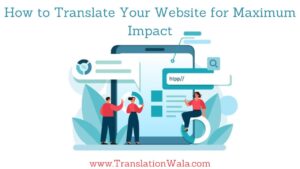Website Translation: Businesses are no longer limited by where they are located in the world because everything is linked. Companies can reach customers all over the world thanks to the growth of the internet. This helps them reach more customers and make more money. But for businesses to really connect with people all over the world, they need to make sure that their online presence is easy for people from all over the world to find and useful. This is where translating websites comes in handy.
Website translation means translating the text of your website into more than one language so that more possible customers can see it. It might seem easy to just change words to their translations in another language, but translating a website well is a complicated process that needs to be carefully planned and carried out.
Define Your Goals
It’s important to set clear goals before starting a website translation job. Why do you want to translate your website? Are you trying to get into new markets, make more people aware of your brand, or make customers happier? Making smart choices during the translation process will be easier if you have clear goals.
Identify Your Target Audience
To translate a website well, you need to know who you’re translating it for. Think about their age, gender, culture, and language choices. This will help you make sure that the translated text is proper for the culture of the people you want to read it.
Choose the Right Translation Method
Website translation can be done in two main ways: by machine translation (MT) or by a person. MT is the process of using software to translate your website’s text instantly. MT has gotten smarter over the past few years, but it might not always translate correctly or with cultural sensitivity in mind. For human translation, on the other hand, you need to hire professional translators who can give you a more accurate and detailed version that takes into account local context.
Localize Your Content
Website translation is more than just changing words. Localization, which changes the material to fit the language and culture of the audience, is also part of it. This could mean using pictures, symbols, and themes that are acceptable for the culture.
Also Read: Translation APIs – Your Gateway to Indian Languages

Consider the Technical Aspects
There are also technical things to think about when translating a website. Your website’s content management system (CMS) should be able to handle more than one language, and the style should be able to be changed to fit different languages.
Test and Proofread
After the translation is done, it’s important to test and carefully read over the translated text. This means making sure the language is correct, easy to understand, and suitable for the culture.
Optimize for Search Engines
Search engine optimization, or SEO, is very important if you want people to be able to see your website in a number of languages. This means converting the meta descriptions, keywords, and other SEO parts of your website.
Also Read: Build Brand Presence in India’s Regional Markets
Maintain Consistency
It is important to keep the translated text consistent as your website changes. This makes sure that the word about your brand is clear and uniform in all languages.
Use Professional Translators
MT can be helpful, but for important content like product details, marketing materials, and customer service pages, it’s best to hire pro interpreters. Professional interpreters can be more accurate, fluent, and sensitive to different cultures.
Continuously Monitor and Improve
Website translation is an ongoing process, and it’s important to keep an eye on the material that has been translated and make it better all the time. This could mean keeping versions up to date as your goods, services, or target group change.
You can make sure that your website translation project is a success by using these tips. This will help you reach more people around the world, connect with them, and reach your business goals. Remember that translating a website well isn’t just about changing words; it’s also about connecting with your audience on a cultural and language level, building trust, and making your brand strong in foreign markets.



